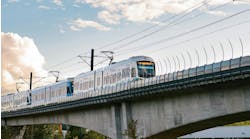MBTA’s D Branch Track and Signal Replacement project wraps up
Massachusetts Bay Transportation Authority (MBTA) has completed work on the D Branch Track and Signal Replacement Project, which is part of the Green Line Transformation. The work included the replacement of 25,000 feet of track and 6.5 miles of signals in an effort to enhance safety, reliability and reliance on the line.
“We’re excited to see the completion of this project, bringing improvements to D branch riders through safer, more reliable Green Line service. We will continue to monitor, test and improve the conditions of the tracks, trains, signals and more across the system,” said MBTA General Manager Steve Poftak. “While the completion of this project is a successful milestone for Capital Transformation, we also recognize that more work needs to be done. We’re committed to making the Green Line fully accessible, and we ask for the community’s continued patience and support while we work towards this goal of improving the overall rider experience for all.”
The D Branch was once a commuter rail route and was converted to a light-rail trolley system in the 1950s, when MBTA installed much of the signal infrastructure that was still in use when this project began. MBTA reports the outdated signals were responsible for 120 signaling incidents on the D Branch during 2017 and 2018. These incidents caused extensive delays and reduced headway adherence. Additionally, when there was a problem experienced within this old system, work crews were required to travel directly on to the tracks to diagnose and fix the issue.
Replacing signals with modern technology increases on-time performance by reducing signal problems and improving the rider experience. The new digital signals can be monitored remotely, which allows MBTA crews to diagnose and fix potential problems faster.
Construction on the project began in 2018, when the average age of the D Branch tracks was more than 30-years old. The track replacement component of the project eliminates more than 2,000 feet of slow zones, which saves 2.5 minutes of travel time in each direction, as well as provides safety and ride quality improvements.
The D Branch Track and Signal Replacement Project was part of MBTA’s Infrastructure Acceleration Plan where the team completed four sets of nine-day, full-access closures during summer 2020 and summer 2021. This allowed crews to complete the most disruptive track work in a short amount of time with the surges bringing the overall project to 95 percent completion following the fourth and final closure.
MBTA says transparency and information sharing were high priorities for the team throughout the project. The Capital Transformation team sent weekly email updates to alert riders and abutters about the planned activities and schedule of the construction. The MBTA says it recognizes that construction can be disruptive, and the team worked to mitigate disruptive noise and other impacts.
Contractors were required to muffle sounds through noise blankets, shielding and sound-deadening material and track panels were assembled offsite in an effort to limit the number of trucks and equipment idling. Questions and noise complaints could be submitted to a 24/7 Project Hotline to ensure that callers could always voice concerns. The full-access closures also reduced the timeframe of impacts: the two D Branch closures completed over a year’s worth of work in 36 days.
“Thank you to everyone for your patience and cooperation throughout this project,” said MBTA Chief of Capital Transformation Angel Peña. “Making these improvements is integral to successfully transforming the Green Line. Future improvements planned for the D Branch will help us reach our goal of making the D Branch the first branch of the Green Line that is fully accessible.”

Mischa Wanek-Libman | Group Editorial Director
Mischa Wanek-Libman is director of communications with Transdev North America. She has more than 20 years of experience working in the transportation industry covering construction projects, engineering challenges, transit and rail operations and best practices.
Wanek-Libman has held top editorial positions at freight rail and public transportation business-to-business publications including as editor-in-chief and editorial director of Mass Transit from 2018-2024. She has been recognized for editorial excellence through her individual work, as well as for collaborative content.
She is an active member of the American Public Transportation Association's Marketing and Communications Committee and served 14 years as a Board Observer on the National Railroad Construction and Maintenance Association (NRC) Board of Directors.
She is a graduate of Drake University in Des Moines, Iowa, where she earned a Bachelor of Arts degree in Journalism and Mass Communication.





